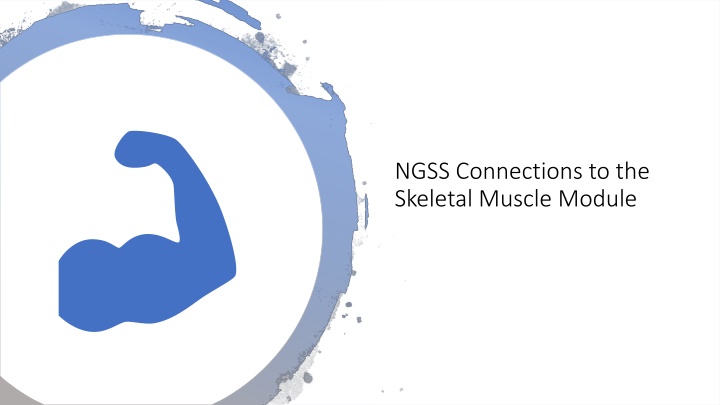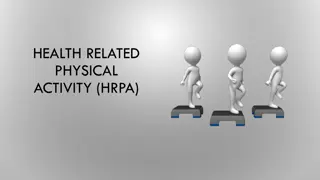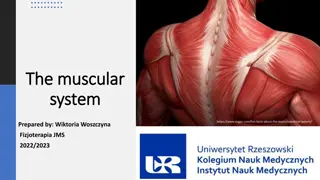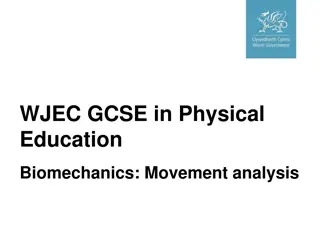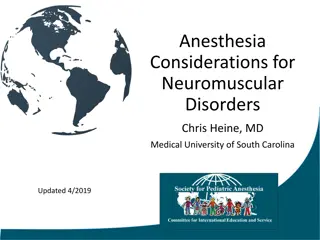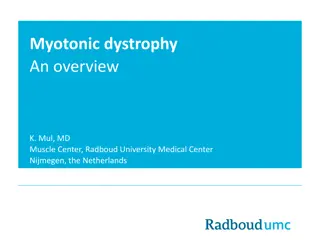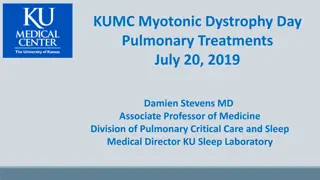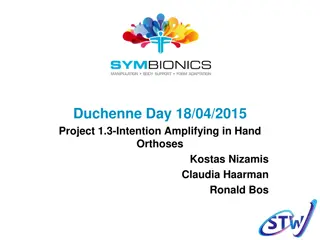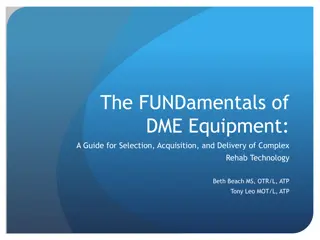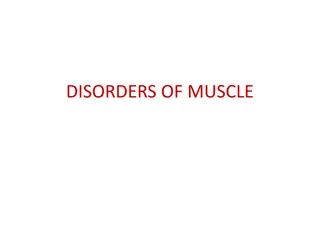Muscular Dystrophy
Muscular Dystrophy is a debilitating disease affecting muscle function. Learn how it impacts individuals and explore research efforts aimed at finding treatments and support strategies for affected individuals and families.
Download Presentation

Please find below an Image/Link to download the presentation.
The content on the website is provided AS IS for your information and personal use only. It may not be sold, licensed, or shared on other websites without obtaining consent from the author.If you encounter any issues during the download, it is possible that the publisher has removed the file from their server.
You are allowed to download the files provided on this website for personal or commercial use, subject to the condition that they are used lawfully. All files are the property of their respective owners.
The content on the website is provided AS IS for your information and personal use only. It may not be sold, licensed, or shared on other websites without obtaining consent from the author.
E N D
Presentation Transcript
NGSS Connections to the Skeletal Muscle Module
NGSS Connections to Skeletal Muscles Module High School Main Connection HS-LS1-2: Develop and use a model to illustrate the hierarchical organization of interacting systems that provide specific functions within multicellular organisms.
NGSS Connections to Skeletal Muscles Module High School Supporting Connections Life Science HS-LS1-1: Construct an explanation based on evidence for how the structure of DNA determines the structure of proteins which carry out the essential functions of life through systems of specialized cells. HS-LS1-3: Plan and conduct an investigation to provide evidence that feedback mechanisms maintain homeostasis. HS-LS3-1: Ask questions to clarify relationships about the role of DNA and chromosomes in coding the instructions for characteristic traits passed from parents to offspring. HS-LS3-2: Make and defend a claim based on evidence that inheritable genetic variations may result from: (1) new genetic combinations through meiosis, (2) viable errors occurring during replication, and/or (3) mutations caused by environmental factors.
NGSS Connections to Skeletal Muscles Module High School Supporting Connections Physcial Science HS-PS3-2: Develop and use models to illustrate that energy at the macroscopic scale can be accounted for as a combination of energy associated with the motion of particles (object) and energy associated with the relative positions of particles (objects). HS-PS3-3: Design, build, and refine a device that works within given constraints to convert one form of energy into another form of energy.
NGSS Connections to Skeletal Muscles Module Middle School Main Connection MS-LS1-2: Develop and use a model to describe the function of a cell as a whole and ways parts of cells contribute to the function. MS-LS1-3: Use argument supported by evidence for how the body is a system of interacting subsystems composed of groups of cells. Supporting Connections MS-LS1-1: Conduct an investigation to provide evidence that living things are made of cells; either one cell or many different numbers and types of cells. MS-LS1-8: Gather and synthesize information that sensory receptors respond to stimuli by sending messages to the brain for immediate behavior or storage as memories.
You and your classmates have just learned that a peer in your class has recently been diagnosed with muscular dystrophy. The student and his family are trying to better understand the disease. Your teacher thinks this is a great idea for your class to research as long as the student and his parents are willing to accept help from the class. She has just learned that they would appreciate the assistance. Skeletal Muscle Story Line To be able to manage this adventure, the teacher will divide the class into groups of four or five students. Each group will complete the first activity in the module.
Your muscles generate electrical activity from the movement of ions. Make hypotheses to answer each of the following questions. 1. How much electrical activity would you expect to measure when your muscles are at rest? (e.g., none, very little, some, a great amount?) Task 1: Making a Hypothesis 2. How will the electrical activity of your muscles change when you move from a resting state to contracting as you lift a weight? 3. What would you expect to see in the electrical activity output when a muscle is fatigued? 4. Will electrical activity in similar states vary across students? What do you expect to observe?
Questions to guide students in data analysis 1. Looking over the data and thinking about what you have learned about muscles, how can you explain the results for lifting weights of different amounts? 2. What causes fatigue and how does lifting weight relate to fatigue? 3. Looking at the data in Table 1, what is the relationship between the time to fatigue and the amount of weight? Task 1 Data Analysis 4. What suggestions would you make to help recover from fatigued skeletal muscles? 5. What might you suggest if a heavy object needed to be carried by hand, such as the books on a rope in these experiments? 6. If an experiment was conducted with the dominant and non-dominant arms, were there differences in the time to fatigue for the same amount of weight lifted? Explain the results.
Task 2: Research and create a physical model of a sarcomere (muscle contractile unit) with accompanying written explanations to describe the cellular anatomy and to illustrate differences between healthy and diseased states. Tasks 2 and 3 Task 3: Conduct a literature search on the disease process of muscular dystrophy and its treatments. Then construct a written summary with drawn diagrams or 3-D models to illustrate differences in the disease state of sarcomeres in persons with muscular dystrophy.
Task 2: Anatomy of the Sarcomere Research how the smallest contractile unit from skeletal muscle, called a sarcomere, works in a healthy state. Look for the basic anatomy of skeletal muscle cells Learn how muscle contraction occurs Draw two diagrams of three skeletal muscle units Relaxed state Contracted state
Task 2: Relaxed Skeletal Muscle Label the actin, myosin, thin filament, thick filament, Z-disk, where the myosin heads are located
Contracted State of Skeletal Muscle Note which bands change in dimension during contraction and which ones do not
Task 2: Drawing 3- Thin Filament A. Draw a third drawing to show an enlarged view of the thin filament with the two actin strands twisted along with the troponins (troponin C, troponin I, and troponin T) and the protein tropomyosin. B. Label where an active site might be located for a myosin head to bind. C. Label the locations of the troponins around an active binding site and illustrate interaction with tropomyosin structure.
Comparison of the thin and thick filaments
More complex illustration of contractile element Use the keyword search terms muscle, titin, sarcomere together to locate information on titan.
Contractile Element illustrating Titin Students can add titan and dystrophin around the figure of the sarcomeres
Task 3: Muscle Structure in Muscular Dystrophy Knowing the location of dystrophin in relation to the contractile units, students can think about answers to the following questions. What would happen if dystrophin was removed from the cell? What would happen if there was a mutation in the protein sequence? Explain what would happen if there was not any dystrophin, or what would happen if there is a mutated form of dystrophin? How would this affect the forces from the contractile elements to the plasma membrane?
Physiology of a Muscle Cell Go through a stepwise sequence process to explain how skeletal muscle contracts as the muscle membrane (sarcolemma) is depolarized due to acetylcholine release from the motor nerve terminal. Acetylcholine (ACh) causes depolarization of the plasma membrane of the muscle An action potential travels along the plasma membrane and down T- tubules. The sarcoplasmic reticulum (SR) inside the muscle cell releases Ca2+ to then raise Ca2+ within the cytoplasm inside the muscle. Ca2+ ions bind with troponin causes tropomyosin to move and an active site is exposed on actin for the myosin head Myosin binds to actin Contraction starts and the sarcomeres shorten The myosin heads releases the ADP, and Pi and comes of the active site while the head rotates back and returns to be ready to bind to an active site again Ca2+ levels return to a lower level in the cytoplasm
Task 2: Research and create a physical model of a sarcomere (muscle contractile unit) with accompanying written explanations to describe the cellular anatomy and to illustrate differences between healthy and diseased states. Tasks 2 and 3 Task 3: Conduct a literature search on the disease process of muscular dystrophy and its treatments. Then construct a written summary with drawn diagrams or 3-D models to illustrate differences in the disease state of sarcomeres in persons with muscular dystrophy.
Task 3: Making Sense of Muscular Dystrophy Student Instructions Your group is tasked with learning about the disease process of muscular dystrophy and treatments. Conducting a literature search using an online search engine such as Google Scholar will provide quick access to information. What follows are some key words to get you started. muscular dystrophy define types of muscular dystrophy what is muscular dystrophy
Task 3: Making Sense of Muscular Dystrophy Next, search on internet how muscular dystrophy develops. Some key words to use are: causes of muscular dystrophy genetics muscular dystrophy List the various causes known for developing the various types of muscular dystrophy. Table 2. Muscular Dystrophy Research Table Types Causes
Task 3: Making Sense of Muscular Dystrophy Next search the internet on treatments and therapy for muscular dystrophy. Some key words to use are: therapy for muscular dystrophy treatment of muscular dystrophy Table 2. Muscular Dystrophy Research Table Types Causes Therapy Treatment
Task 4: Public Awareness Information Display Task 4: Public Awareness Information Display or Poster or Poster Here are some ideas: Create a poster or a Piktochart to illustrate sarcomeres and how they work, what happens in the disease state of muscular dystrophy, and possible treatments.
Task 4: Public Awareness Information Display Plan a 3-D display to illustrate healthy working muscle cells in comparison to muscle cells in disease state of muscular dystrophy. Other hands-on activities could be planned around a tabling event, such as EMG activities models, and other pamphlets distributed to the public.
Display Criteria Demonstrate the anatomy of skeletal muscle and how muscle contraction occurs Define muscular dystrophy and how the disease occurs Differentiate the types of muscular dystrophy and demarcate the forms. Show where the dystrophin complex is located and how this can effect muscle strength and weakness Present current treatments and therapies for muscular dystrophy. Task 4: Task 4: Awareness Awareness Information Information Display or Display or Poster Poster
